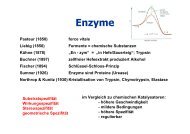Transglutaminase-1 and Bathing Suit Ichthyosis: Molecular Analysis ...
Transglutaminase-1 and Bathing Suit Ichthyosis: Molecular Analysis ...
Transglutaminase-1 and Bathing Suit Ichthyosis: Molecular Analysis ...
You also want an ePaper? Increase the reach of your titles
YUMPU automatically turns print PDFs into web optimized ePapers that Google loves.
Table 1. Reconstitution of TGase-1 activity<br />
Arg687His) are involved in such interactions<br />
with surrounding residues. Removing<br />
or adding a polar group in the<br />
protein core leaves a hydrogen-bond<br />
donor or a acceptor unsatisfied (Boeshans<br />
et al., 2007). Several residues<br />
affected in BSI (for example, Tyr276,<br />
Arg264, Arg307, <strong>and</strong> Arg315) are<br />
exposed to the solvent (Figure 2) <strong>and</strong><br />
mutations could possibly influence the<br />
intrinsic salvation properties, local surface<br />
polarity, or surface hydrophobicity.<br />
Our current biochemical results on<br />
the reconstitution of deficient TGase-1<br />
activity in BSI patients by decreasing<br />
the temperature to 31 1C further support<br />
these predictions from the atomic modeling.<br />
Samples pre-incubated at 30 <strong>and</strong><br />
40 1C for 30 minutes were assayed at<br />
31 1C. The mutations associated with<br />
BSI display activities ranging from<br />
11.34 to 16.25% (Table 1). In contrast<br />
to the temperature screening, no differ-<br />
ences in activity could be detected.<br />
This is indicative of a reconstituted<br />
enzyme activity in the pre-incubated<br />
samples. In contrast, the classical mutations<br />
in TGase-1 revealed a decrease of<br />
activity after pre-incubation at 40 1C,<br />
similar to the activity at 37 1C.<br />
As shown in Figure 1d <strong>and</strong> e <strong>and</strong><br />
Table 1, at temperatures above 33 1C,<br />
activities of the BSI mutants decline to<br />
below 10% <strong>and</strong> clinical ichthyosis<br />
develops. The two mutations known to<br />
cause classical LI type 1 only show<br />
activities below 7.5%. This indicates<br />
the predisposition of relative activities<br />
below 10% to the development of the<br />
local scaling in BSI.<br />
We conclude that the striking distribution<br />
of scaling in BSI is due to<br />
mutations that render TGase-1 sensitive<br />
to temperatures above 33 1C. A similar<br />
situation has been reported for autosomal-recessive<br />
oculocutaneous albin-<br />
Temperature (1C)<br />
Protein Nucleotide change Phenotype Expression Pre-incubation Assay Relative activity (%)<br />
Tyr276Asn c.826T4A BSI + 40 31 13.57±0.46<br />
30 31 14.01±0.79<br />
Arg126Cys c.376C4T BSI + 40 31 13.61±0.52<br />
30 31 12.99±0.57<br />
Arg264Trp c.790C4T BSI + 40 31 12.98±0.98<br />
30 31 11.34±0.52<br />
Arg307Gly c.919C4G BSI + 40 31 13.87±1.36<br />
30 31 12.89±1.54<br />
Arg264Gln c.791G4A BSI + 40 31 13.99±0.79<br />
30 31 13.44±0.52<br />
Arg687His c.2060G4A BSI + 40 31 15.76±0.33<br />
30 31 16.25±1.13<br />
Arg315Cys c.843C4T BSI + 40 31 13.45±0.52<br />
30 31 13.47±0.25<br />
Arg315His c.844G4A BSI + 40 31 13.28±0.34<br />
30 31 12.76±0.56<br />
Arg142His c.425G4A Classical LI + 40 31 2.67±0.89<br />
30 31 5.69±0.65<br />
Arg389Pro c.1166G4C Classical LI + 40 31 2.75±0.72<br />
30 31 4.88±0.85<br />
Ser358fsX26 c.1074delC Classical LI Not tested 1,2<br />
BSI, bathing suit ichthyosisl; LI, lamellar ichthyosis; TGase, transglutaminase-1.<br />
Data are displayed as relative activity in percentage (%).<br />
1 Nonsense mutation.<br />
2 After transfection, the mutant enzyme did not show any expression.<br />
K Aufenvenne et al.<br />
<strong>Molecular</strong> <strong>Analysis</strong> of Gene/Environment Interactions<br />
ism, where hypopigmentation is related<br />
to local body temperature due to a<br />
temperature-sensitive mutation in<br />
human tyrosinase. It has been proposed<br />
that the thermo-sensitive tyrosinase<br />
directly interferes with thermal stability<br />
of the protein (Giebel et al., 1990;<br />
Berson et al., 2000). Another cutaneous<br />
phenotype in which body temperature<br />
plays an important role has been<br />
described for a mutation in CDKN2A<br />
(cyclin-dependent kinase inhibitor 2A),<br />
which is associated with an increased<br />
rate of nevus development <strong>and</strong> density<br />
on warmer body regions (Florell et al.,<br />
2004). It is tempting to speculate that<br />
gene/environment interactions relating<br />
to body temperature may be relevant<br />
for further skin diseases <strong>and</strong> are not<br />
adequately appreciated so far.<br />
CONFLICT OF INTEREST<br />
The authors state no conflict of interest.<br />
www.jidonline.org 3




